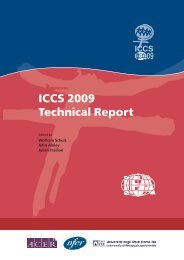Teacher Education and Development Study in Mathematics - IEA
Teacher Education and Development Study in Mathematics - IEA
Teacher Education and Development Study in Mathematics - IEA
Create successful ePaper yourself
Turn your PDF publications into a flip-book with our unique Google optimized e-Paper software.
62<br />
TEACHER PAY AND STUDENT MATHEMATICS ACHIEVEMENT<br />
Bulgaria<br />
Composition of the teacher labor force<br />
The Bulgarian education system went through major changes <strong>in</strong> the 1990s with the<br />
economic shift from a comm<strong>and</strong> to a market economy. Low birth rates also contributed<br />
to the change. Enrollment <strong>in</strong> primary <strong>and</strong> secondary school fell steadily (Bulgaria has<br />
experienced one of the largest decl<strong>in</strong>es <strong>in</strong> Europe), but there was a steep rise <strong>in</strong> the<br />
number of students <strong>in</strong> higher education, from 120,000 <strong>in</strong> 1990 to 258,000 <strong>in</strong> 2000, a<br />
trend that is cont<strong>in</strong>u<strong>in</strong>g. Enrollment rates after Grade 8 are relatively low, with only<br />
about 67% of the age cohort cont<strong>in</strong>u<strong>in</strong>g to secondary school. The school system<br />
seems to focus more on selection than on retention. <strong>Teacher</strong>s <strong>in</strong> primary school are<br />
predom<strong>in</strong>antly female. However, as <strong>in</strong> other European countries, the gap between the<br />
number of female teachers <strong>and</strong> the number of male teachers is not as wide <strong>in</strong> secondary<br />
schools. At both levels, there is a fall<strong>in</strong>g dem<strong>and</strong> for teachers.<br />
<strong>Education</strong>al f<strong>in</strong>anc<strong>in</strong>g is both centralized (state schools) <strong>and</strong> decentralized (municipal<br />
schools). The latter are funded by a comb<strong>in</strong>ation of block grants from the M<strong>in</strong>istry<br />
of F<strong>in</strong>ance for Social Services, a share of municipal tax revenues, <strong>and</strong> extra-budgetary<br />
funds raised by the schools themselves.<br />
<strong>Teacher</strong> education<br />
Both primary <strong>and</strong> secondary school teachers receive their education <strong>in</strong> universities.<br />
Secondary school teachers must major <strong>in</strong> the subject they <strong>in</strong>tend to teach. Primary<br />
school teachers (Grades 1 to 4) obta<strong>in</strong> their qualifications from departments of primary<br />
education with<strong>in</strong> the faculties of pedagogy at the universities. They are tra<strong>in</strong>ed to teach<br />
all subjects. From Grade 5 on, each class has a special mathematics teacher; these middle<br />
<strong>and</strong> secondary school teachers are required to study mathematics at university level.<br />
<strong>Teacher</strong> salaries<br />
Although teacher salaries are low, they are not much lower than salaries <strong>in</strong> compet<strong>in</strong>g<br />
professions. In the early 2000s, the maximum salary a Grade 1 teacher could expect to<br />
receive after 25 years of teach<strong>in</strong>g was 259 leva per month (about $US130). <strong>Teacher</strong> salary<br />
differentials from one step on the teacher scale to the next is also low, only eight leva<br />
(approximately $US4) per month, so that the difference between a beg<strong>in</strong>n<strong>in</strong>g teacher<br />
(Level I) <strong>and</strong> a teacher with the highest qualification (Level V) is only 40 leva or $US20<br />
per month. There seems to be little or no <strong>in</strong>centive for teachers to develop professionally,<br />
especially given that <strong>in</strong>-service teacher education courses can be expensive. In the new<br />
market economy, teachers can supplement their salaries through other work, reduc<strong>in</strong>g<br />
their time for non-classroom teach<strong>in</strong>g activities such as class preparation, correction of<br />
homework, availability for school plann<strong>in</strong>g meet<strong>in</strong>gs, <strong>and</strong> <strong>in</strong>-service education.<br />
While teach<strong>in</strong>g is still a respected profession, its status appears to be dim<strong>in</strong>ish<strong>in</strong>g.<br />
Despite this, <strong>and</strong> the apparent erosion of relative salaries, three factors mitigate aga<strong>in</strong>st a<br />
future shortage of teachers: (i) decl<strong>in</strong><strong>in</strong>g absolute enrollment <strong>in</strong> primary <strong>and</strong> secondary<br />
schools, (ii) exp<strong>and</strong><strong>in</strong>g enrollment <strong>in</strong> universities, <strong>and</strong> (iii) a shortage of jobs for<br />
university graduates. Nevertheless, the quality of university graduates enter<strong>in</strong>g teach<strong>in</strong>g<br />
may decl<strong>in</strong>e, a situation that could affect the quality of mathematics teachers more than<br />
the quality of other teachers.

















